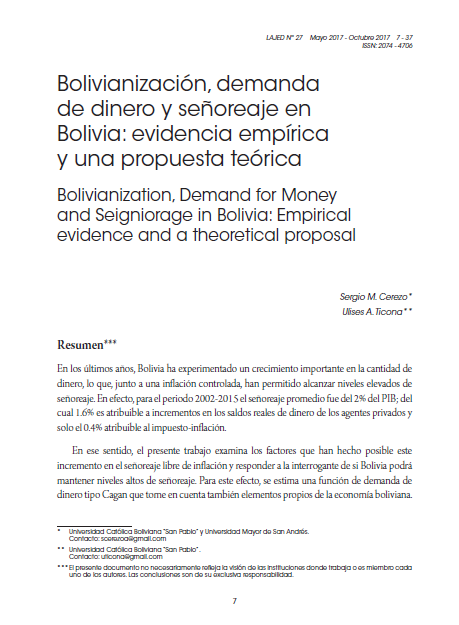Bolivianization, Demand for Money and Seigniorage in Bolivia: Empirical evidence and a theoretical proposal
DOI:
https://doi.org/10.35319/lajed.20162750Keywords:
Bolivianization, demand for money, seigniorageAbstract
In recent years, Bolivia has experienced a significant increase in the stock of money, which, along with subdued inflation, have led to higher levels of seigniorage. In fact, during the period 2002-2015 the average ratio of seigniorage was about 2% of GDP (1.6% attributable to increases in the real money balances of private agents and 0.4% attributable to the inflation tax). In this sense, the present paper examines the factors that explain this increase in seigniorage without originating higher rates of inflation and analyzes whether Bolivia can maintain high levels of seigniorage in the future. For this purpose, a Cagan function of money demand is estimated taking into account intrinsic features of the Bolivian economy. The results show that income, deposit interest rates and financial dedollarization would have contributed greatly to the increase in money demand of national currency, especially since 2006. On the other hand, the boost of dedollarization to both, the demand for money and seignorage, is weak because it is near its upper limit. Finally, the paper presents a theoretical proposal, which unlike a Laffer - Bailey curve that relates inflation to seigniorage, proposes a relationship between dedollarization and seigniorage.
Downloads
References
Arce, L. 2003. “La demanda por dinero en Bolivia 1990-2002”. Dinámica Económica Nueva Época 10(12) Instituto de Investigaciones Económicas de la UMSA.
Asilis, C., P. Honohan y P. McNelis. 1993. “Money demand during hyperinflation and stabilization: Bolivia, 1980-1988”. Economic Inquiry, 31(2), 262.
Boyreau-Debray, G. 1998. “Money Demand and the Potential of Seigniorage in China” (Nº 199821).
Cagan, P. 1956. “The monetary dynamics of hyperinflation”. En: M. Friedman, Studies in the Quantity Theory of Money. Chicago: University of Chicago Press, pp. 25-117.
Cossío, J., M. Laguna, D. Martin, P. Mendieta, R. Mendoza, M. Palmero y H. Rodríguez. 2008. “La inflación y políticas del Banco Central de Bolivia”. Revista de Análisis del Banco Central de Bolivia, 10, 73.
Dowd, K. 1994. “The Costs of Inflation and Disinflation” The Cato Journal, 14(2), 305-331.
Drazen, A. 1985. “A general measure of inflation tax revenue”. Economic Letters, 17, 327-330.
Dupuy, M. 1993. “Essai de vérification de la théorie du seigneuriage optimal pour les pays de la CEE”. Revue d’Economie Politique, 103(1), 98-130.
Honohan, P. 1996. “Does it matter how seigniorage is measured?”. Applied Financial Economics, 6(3), 293-300.
Húmerez, J. y F. Rojas. 1996. “Estimación de la función de demanda por dinero en el periodo de la post-estabilización en Bolivia”. Disponible en: http://www.udape.gob.bo/portales_html/AnalisisEconomico/analisis/vol15/art07.pdf
Laffer, A. 1981. “Government exactions and revenue deficiencies”. The Cato Journal, 1:21.
Orellana, W. 1999. “La estabilidad de la demanda de bolivianos luego del proceso hiperinflacionario: 1986-1997”. Banco Central de Bolivia. Revista de Análisis del Banco Central de Bolivia, 1(1).
Sriram, S. 2000. “A survey of recent empirical money demand studies”. IMF Economic Review, 47(3), 334-365.






